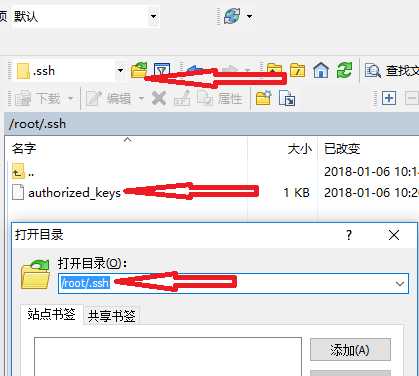刚装玩fedora,那么我们就以fedora为例来说一下怎么配置:
1、先确认是否已安装ssh服务:
[root@localhost ~]# rpm -qa | grep openssh-server
openssh-server-5.3p1-19.fc12.i686 (这行表示已安装)
若未安装ssh服务,可输入:
#yum install openssh-server
进行安装
2、winscp登陆,用root密码登陆。
3、修改配置文件:
#vi /etc/ssh/sshd_config
winscp登陆的话,就直接修改/etc/ssh/sshd_config
找到AuthorizedKeysFile .ssh/authorized_keys
这就是存在服务器上的公钥文件,一行一个。
自己创建一下
完整路径是 /root/.ssh
在winscp下要用一下手动打开(ctrl+o),.ssh隐藏了,打开路径/root/.ssh
如果不存在,就在root下手动创建一个.ssh文件夹

新建文件,复制你的公钥那行保存
找到:PasswordAuthentication yes
允许密码登陆,改为no,禁止密码登陆。

下面是对SSH配置文件的一些选项的分解说明,ssh_config是OpenSSH客户端的配置文件,sshd_config是OpenSSH服务器端的配置文件。 ssh_config的内容如下: # This is the ssh client system-wide configuration file. See ssh_config(5) for more information. This file provides defaults for users, and the values can be changed in # er-user configuration files or on the command line. # Configuration data is parsed as follows: // 配置选项生效的优先级 # 1. command line options // 命令行选项 # 2. user-specific file // 用户指定文件 # 3. system-wide file // 系统范围的文件 # Any configuration value is only changed the first time it is set. Thus, host-specific definitions should be at the beginning of the configuration file, and defaults at the end. # Site-wide defaults for some commonly used options. For a comprehensive list of available options, their meanings and defaults, please see the ssh_config(5) man page. Host * // 使用的计算机范围,‘*‘表示全部 # ForwardAgent no // 设置连接是否经过验证代理(如果存在)转发给远程计算机 # ForwardX11 no // 设置X11连接是否被自动重定向到安全的通道和显示集 # ForwardX11Trusted yes // 是否允许转发X11会话 # RhostsRSAAuthentication no // 设置是否使用RSA进行rhosts的安全验证 # RSAAuthentication yes // 设置是否使用RSA进行安全验证 # PasswordAuthentication yes // 设置是否需要口令验证 # HostbasedAuthentication no # GSSAPIAuthentication no # GSSAPIDelegateCredentials no # GSSAPIKeyExchange no # GSSAPITrustDNS no # BatchMode no // 如果为yes,则交互输入口令时的提示(passphrase/password的提示)信息将被禁止 # CheckHostIP yes // 设置SSH是否查看连接到服务器的主机的IP地址以防止DNS欺骗。建议设置为yes # AddressFamily any # ConnectTimeout 0 # StrictHostKeyChecking ask // 如果设置成yes,SSH就不会自动把计算机的密钥加入$HOME/.ssh/known_hosts文件,并且一旦计算机的密匙发生了变化,就拒绝连接 # IdentityFile ~/.ssh/identity # IdentityFile ~/.ssh/id_rsa // RSA安全验证文件的位置 # IdentityFile ~/.ssh/id_dsa // DSA安全验证文件的位置 # Port 22 // 服务器端口 # Protocol 2,1 // 使用的SSH协议 # Cipher 3des // 设置加密的方式 # Ciphers aes128-ctr,aes192-ctr,aes256-ctr,arcfour256,arcfour128,aes128-cbc,3des-cbc # MACs hmac-md5,hmac-sha1,umac-64@openssh.com,hmac-ripemd160 # EscapeChar ~ // 设置Escape(转义)字符 # Tunnel no # TunnelDevice any:any # PermitLocalCommand no # VisualHostKey no # ProxyCommand ssh -q -W %h:%p gateway.example.com SendEnv LANG LC_* // 局部环境变量 HashKnownHosts yes GSSAPIAuthentication yes GSSAPIDelegateCredentials no sshd_config的内容如下: # Package generated configuration file See the sshd_config(5) manpage for details # What ports, IPs and protocols we listen for Port 22 // sshd的监听端口号,默认为22 # Use these options to restrict which interfaces/protocols sshd will bind to #ListenAddress :: #ListenAddress 0.0.0.0 // 设置sshd服务绑定的IP地址,0.0.0.0表示侦听所有地址 Protocol 2 // 默认只使用2.*版本的SSH协议 # HostKeys for protocol version 2 HostKey /etc/ssh/ssh_host_rsa_key // SSH2版本的RSA密钥存放位置 HostKey /etc/ssh/ssh_host_dsa_key // SSH2版本的DSA密钥存放位置 HostKey /etc/ssh/ssh_host_ecdsa_key // SSH2版本的ECDSA密钥存放位置 #Privilege Separation is turned on for security UsePrivilegeSeparation yes # Lifetime and size of ephemeral version 1 server key KeyRegenerationInterval 3600 // 密钥每隔1小时生成一次 ServerKeyBits 768 // SSH服务器密钥的位数 # Logging SyslogFacility AUTH // 设置sshd发送到syslog所使用的日志类型 // 设置在记录来自sshd的消息时是否给出facility code LogLevel INFO // syslog日志级别 # Authentication: LoginGraceTime 120 // 设置如果用户不能成功登录,sshd将会在这个配置参数指定的时间过后断开连接(单位为秒) PermitRootLogin yes // 如果为yes则允许root用户使用ssh登录,为no则表示不允许root进行ssh登录 StrictModes yes // 设置sshd在接受登录请求前是否检查用户的主目录以及rhosts文件的权限和所有者等信息。防止目录和文件设成任何人都有写权限 RSAAuthentication yes // 是否允许RSA验证 PubkeyAuthentication yes // 是否允许公钥验证 AuthorizedKeysFile %h/.ssh/authorized_keys// 公钥文件存放的位置 # Don‘t read the user‘s ~/.rhosts and ~/.shosts files IgnoreRhosts yes // 验证时是否使用‘~/.rhosts‘和‘~/.shosts‘文件 # For this to work you will also need host keys in /etc/ssh_known_hosts RhostsRSAAuthentication no // 设置是否允许用rhosts或/etc/hosts.equiv加上RSA进行安全验证 # similar for protocol version 2 HostbasedAuthentication no # Uncomment if you don‘t trust ~/.ssh/known_hosts for RhostsRSAAuthentication #IgnoreUserKnownHosts yes // 设置sshd在进行RhostsRSAAuthentication安全验证时是否信任用户的‘~/.ssh/known_hosts‘文件 # To enable empty passwords, change to yes (NOT RECOMMENDED) PermitEmptyPasswords no // 设置是否允许用空口令登录 # Change to yes to enable challenge-response passwords (beware issues with # some PAM modules and threads) ChallengeResponseAuthentication no // 设置是否允许使用提示/应答式认证。sshd支持login.conf文件中定义的所有认证类型 # Change to no to disable tunnelled clear text passwords #PasswordAuthentication yes // 设置是否需要口令验证,默认为yes # Kerberos options // Kerneros验证 #KerberosAuthentication no #KerberosGetAFSToken no #KerberosOrLocalPasswd yes #KerberosTicketCleanup yes # GSSAPI options // GSSAPI 验证 #GSSAPIAuthentication no #GSSAPICleanupCredentials yes // 清除验证信息 X11Forwarding yes // 设置sshd是否允许X11转发,默认为允许 X11DisplayOffset 10 PrintMotd no // 设置sshd是否在用户登录时显示/etc/motd中的信息 PrintLastLog yes // 交互式登录时是否输出用户上次登录的日期和时间 TCPKeepAlive yes // TCP活动保持 #UseLogin no // 指定login命令是否可用于交互式登录会话 #MaxStartups 10:30:60 #Banner /etc/issue.net // 设置保存banner信息的文件位置,用户登录后会显示该banner信息 # Allow client to pass locale environment variables AcceptEnv LANG LC_* // 指定客户端发送的那些环境变量能后复制到当前会话的运行环境(客户端需要设置其配置文件ssh_config中的SendEnv参数) Subsystem sftp /usr/lib/openssh/sftp-server // 用于配置一个外部的服务程序,如文件传输服务器sftp-server。配置参数的值应该是一个系统名与命令,能够基于客户系统的请求开始运行。sftp-server命令实现了sftp文件传输子系统。这个配置参数仅使用与SSH2 # Set this to ‘yes‘ to enable PAM authentication, account processing, and session processing. If this is enabled, PAM authentication will be allowed through the # ChallengeResponseAuthentication and PasswordAuthentication. Depending on your PAM configuration, PAM authentication via ChallengeResponseAuthentication # may bypass the setting of "PermitRootLogin without-password". If you just want the PAM account and session checks to run without PAM authentication, then enable #this but set PasswordAuthentication and ChallengeResponseAuthentication to ‘no‘. UsePAM yes // 是否启用PAM插件式认证模块,默认为yes
关于配置文件的详细说明,留着,不用看。
禁止了密码登陆,设置了公钥。
重启sshd,在终端窗口运行:
systemctl restart sshd.service
可以配置winscp用私钥登陆了。

